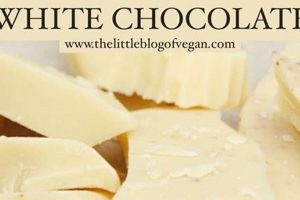A dairy-free and egg-free topping for cakes, this type of confection emulates the traditional German chocolate cake accompaniment. It typically features a coconut and pecan base bound by a sweetened, thickened liquid, often derived from plant-based milk and sweeteners. For example, a cake decorated with this topping allows individuals following a plant-based diet to enjoy a classic dessert flavor.
Its significance lies in its ability to provide an inclusive dessert option for those with dietary restrictions or ethical considerations. Furthermore, developing alternatives to traditional recipes can contribute to a more sustainable food system. While the specific origins of German chocolate cake are debated, its popularity in American baking traditions makes a plant-based variant a relevant and accessible adaptation.
The subsequent discussion will delve into specific ingredient substitutions, common preparation methods, and potential variations within this culinary area. It also may explore considerations regarding texture and flavor profiles achieved through different plant-based approaches.
Preparation Guidelines
Achieving optimal results requires careful consideration of ingredients and techniques. The following tips provide guidance for successful preparation.
Tip 1: Select Appropriate Plant-Based Milk: Coconut milk, especially full-fat varieties, often provides the richest texture and flavor profile, mimicking the traditional dairy-based component. Almond or soy milk can be used as alternatives, but may require adjustments to sweetness or thickening agents.
Tip 2: Toast Coconut and Pecans: Toasting intensifies the natural flavors of the coconut and pecans, adding depth and complexity to the final product. Monitor closely to prevent burning, as scorched nuts will impart an undesirable taste.
Tip 3: Adjust Sweetener Levels: Plant-based sweeteners, such as maple syrup or agave nectar, possess varying degrees of sweetness compared to refined sugar. Adjust quantities accordingly to achieve the desired level of sweetness without overpowering other flavors.
Tip 4: Control the Thickening Process: Cornstarch or tapioca starch can effectively thicken the liquid base. Ensure the starch is fully dissolved before adding to the mixture to prevent lumps. Simmer gently, stirring constantly, until the desired consistency is reached.
Tip 5: Incorporate a Pinch of Salt: A small amount of salt enhances the other flavors, balancing the sweetness and bringing out the nutty notes of the coconut and pecans.
Tip 6: Allow Sufficient Cooling Time: Cooling allows the flavors to meld and the texture to firm up. Refrigerate for at least an hour before applying to the cake.
Tip 7: Consider the Consistency: For easier spreading, add a touch more of your plant-based milk. For a thicker consistency, simmer a few minutes longer.
Implementing these guidelines will contribute to a more successful and flavorful outcome, ensuring a delectable complement to the cake.
The subsequent sections will explore variations and advanced techniques for refining the taste and presentation.
1. Plant-Based Milk
Plant-based milk constitutes a critical component of the dairy-free topping. The absence of traditional dairy milk necessitates a substitute to provide moisture, richness, and binding properties within the confection. The selection of plant-based milk directly impacts the final texture, flavor profile, and overall success of the replication. For example, coconut milk, due to its high fat content, often mimics the richness of dairy milk in conventional recipes, yielding a creamier product. Conversely, almond milk, lower in fat, can result in a thinner consistency unless augmented with thickening agents. The cause-and-effect relationship is therefore evident: the type of plant-based milk used determines the texture and, to some extent, the flavor of the end product.
Beyond its functional role, the choice also aligns with the ethical and dietary motivations behind veganism. Utilizing dairy alternatives enables individuals to adhere to plant-based principles without sacrificing the enjoyment of traditional desserts. Real-world examples include recipes employing oat milk for a neutral flavor or cashew milk for a smoother texture, showcasing the versatility of plant-based options. The practical significance lies in the ability to adapt and customize the recipe based on individual preferences and available ingredients, ensuring broader accessibility and inclusivity.
In summary, plant-based milk serves as a cornerstone in creating a dessert topping. Its selection dictates crucial textural and flavor attributes. Understanding this relationship empowers bakers to make informed decisions, optimize recipes, and cater to dietary needs while preserving the essence of the classic treat. The primary challenge revolves around replicating the complex properties of dairy milk, requiring experimentation and adaptation.
2. Coconut Flakes
Coconut flakes constitute a defining element of this particular style of topping. Their inclusion directly contributes to the characteristic texture and flavor profile associated with the dessert. Without coconut flakes, the resulting product would deviate significantly from the expected taste and mouthfeel, rendering it unrecognizable as a component of German chocolate cake. The presence of shredded coconut provides a fibrous chewiness and a distinctive tropical sweetness, acting as both a textural contrast to the other ingredients and a primary flavor component.
The cause-and-effect relationship is evident: the addition of coconut flakes creates the recognizable character. For instance, various recipes prominently feature toasted coconut as a method for amplifying the nutty flavor and adding a further dimension to the texture. From a practical standpoint, the type of coconut flake usedwhether desiccated, shredded, or flakedinfluences the final consistency. Larger flakes provide a more pronounced textural impact, while finer desiccated coconut integrates more seamlessly. Moreover, understanding this interplay allows for adjustments to suit preferences or dietary restrictions, potentially utilizing unsweetened varieties to control sugar content.
In summary, coconut flakes are integral to the identity and sensory experience. Their presence delivers crucial texture and flavor, making them an irreplaceable component. Omission or substitution would fundamentally alter the nature of the dessert topping. Experimentation with different forms of coconut flakes permits customization and adaptation, thus ensuring accessibility and culinary versatility. The persistent challenge lies in balancing the coconut flavor with other elements, preventing it from becoming overpowering while maintaining its distinctive contribution.
3. Pecan Integration
Pecan integration is a critical component of the described plant-based dessert topping, contributing significantly to both its texture and flavor profile. Pecans introduce a nutty richness and a subtle bitterness that balances the sweetness of the coconut and the plant-based milk. The absence of pecans would result in a decidedly different confection, lacking the characteristic depth and complexity expected in this variety of frosting. The method of pecan integration, whether finely chopped, coarsely ground, or used as pecan halves for garnish, impacts the overall sensory experience. Consider, for example, that coarsely chopped pecans provide a more pronounced textural element, while finely ground pecans meld more seamlessly into the base, contributing primarily to flavor. Therefore, the form in which pecans are incorporated directly affects the final product’s palatability and aesthetic appeal.
Understanding the impact of pecan preparation enables bakers to customize the recipe. Toasting pecans before inclusion, for instance, intensifies their flavor and adds a further layer of complexity. Similarly, the quantity of pecans used influences the overall nuttiness and texture. A higher proportion of pecans will create a denser, more intensely flavored frosting, while a smaller proportion will yield a lighter, more subtle result. The practical significance of this understanding lies in the ability to adjust the recipe to suit individual preferences or dietary restrictions, such as those related to nut allergies or texture sensitivities. Some recipes may partially substitute pecans with other nuts, such as walnuts or almonds, albeit with a resulting alteration to the established flavor profile.
In summary, pecans are an indispensable element, contributing essential flavor and textural components. Pecan integration method significantly shapes the end product. Bakers can skillfully adapt recipes to meet specific tastes by manipulating the form and quantity of pecans, while acknowledging potential alterations to the characteristic flavor. The ongoing challenge lies in achieving a balanced flavor profile, ensuring that the pecan notes complement, rather than overpower, the other ingredients, thus preserving the essence of the intended dessert topping.
4. Sweetener Choice
Sweetener choice significantly affects the final flavor profile, texture, and overall success of plant-based German chocolate topping. The selection extends beyond mere sweetness; it influences the moisture content, caramelization potential, and interaction with other ingredients. Thus, careful consideration is warranted.
- Type of Sweetener
Different sweeteners impart distinct flavor notes. Refined sugars provide pure sweetness, while options like maple syrup introduce caramel undertones. Date syrup provides a richer, molasses-like taste and a darker color. The selection alters the topping’s final taste, impacting its authenticity relative to traditional versions. The practical significance is the capacity to customize according to individual preferences or dietary needs, such as minimizing refined sugar intake.
- Sweetness Intensity
Various sweeteners possess differing sweetness levels. Agave nectar, for example, is sweeter than granulated sugar, necessitating quantity adjustments to achieve comparable results. Over-sweetening can mask other flavors, while under-sweetening may result in a bland product. Proper calibration is crucial for balancing the overall flavor profile. An understanding of relative sweetness intensities facilitates accurate recipe conversions and adjustments.
- Moisture Content
Liquid sweeteners, such as maple syrup or agave nectar, contribute moisture to the topping. Conversely, granulated sweeteners, while offering less moisture directly, may influence the overall consistency by affecting the behavior of other ingredients. This balance is critical for attaining the desired spreadable texture. Adjustments to dry and wet ingredients might be necessary to compensate for fluctuations in moisture levels introduced by the selected sweetener.
- Impact on Caramelization
Certain sweeteners, especially those containing fructose or glucose, promote caramelization during the cooking process. This chemical reaction enhances the flavor complexity and contributes to a richer, more nuanced taste. Refined sugars caramelize readily, while others, like stevia, lack this capacity. The choice, therefore, influences the depth of flavor and color development within the plant-based topping.
The preceding facets illustrate the intricate relationship between sweetener choice and the characteristics. From influencing overall flavor to the degree of caramelization, each sweetener has properties that either enhances or detracts from the final result. Selecting the optimal sweetener requires considering personal taste, dietary restrictions, and the desired flavor depth, collectively ensuring a balanced and successful plant-based version.
5. Texture Control
Texture control represents a critical aspect in the successful preparation. The goal is to achieve a consistency that mirrors the traditional, non-vegan counterpart while adhering to plant-based ingredients. This requires a nuanced understanding of how various elements interact to affect the overall mouthfeel and spreadability of the final product.
- Influence of Plant-Based Milk
The type of plant-based milk employed has a significant impact on the final texture. High-fat coconut milk, for instance, yields a richer, creamier consistency, while lower-fat options like almond milk require thickening agents to achieve a comparable result. The water content within different milk alternatives also influences the overall moisture level, necessitating careful adjustment of dry ingredients to maintain proper balance. For example, using excessive amounts of almond milk without compensation may result in a thin, watery topping. This factor underscores the need for careful ingredient selection to match the target texture.
- Role of Thickening Agents
Thickening agents, such as cornstarch or tapioca starch, are frequently used to compensate for the lack of traditional dairy components. These starches, when properly incorporated, create a viscous structure that emulates the body provided by dairy. However, improper use can lead to undesirable textures, such as a gummy or excessively thick consistency. The activation temperature and dispersion technique are vital considerations. For instance, failing to dissolve cornstarch fully before heating will result in lumps, while overheating can cause the starch to break down, losing its thickening properties. Mastery of thickening agents is therefore vital for achieving optimal mouthfeel.
- Impact of Coconut Flake Consistency
The size and type of coconut flakes influence the texture. Finely shredded coconut integrates smoothly, contributing to a more homogenous consistency, while larger flakes provide a more pronounced chewiness. The level of moisture in the coconut also plays a role. Dried, desiccated coconut absorbs more liquid, potentially resulting in a drier, thicker product. Therefore, the choice between desiccated, shredded, or flaked coconut impacts the overall texture, offering bakers the opportunity to fine-tune the final product to suit their preferences.
- Effect of Cooling and Setting
Cooling time significantly affects the final texture. As the frosting cools, the starches gelatinize and the fats solidify, leading to a firmer consistency. Insufficient cooling may result in a runny, unstable product, while excessive chilling can lead to a hardened, difficult-to-spread topping. The optimal cooling time varies depending on the specific ingredients and proportions used, requiring careful monitoring and adjustment. For example, a frosting made with a high proportion of coconut oil may require a shorter cooling period to prevent excessive hardening.
These facets illustrate the interconnectedness of texture control. Achieving a desirable consistency requires a holistic approach that considers the interplay of ingredients and techniques. By carefully managing these factors, bakers can create a plant-based dessert topping that meets both ethical and culinary expectations, providing a satisfying alternative to traditional formulations.
6. Flavor Balance
Flavor balance represents a pivotal determinant of success in vegan German chocolate frosting. The interplay between sweetness, bitterness, nuttiness, and coconut notes creates the complex profile characteristic of this topping. Imbalances can lead to an unpalatable result, where one dominant flavor overshadows the others, diminishing the overall sensory experience. For instance, excessive sweetness, often stemming from overcompensation with plant-based sweeteners, can mask the subtle nuances of pecan and coconut, reducing the topping to a one-dimensional, cloying confection. The cause-and-effect relationship is evident: each ingredient’s contribution must be carefully calibrated to achieve harmonious flavor integration. Flavor balance is the critical framework upon which the authenticity of the topping is built.
Achieving a harmonious flavor profile requires strategic application of techniques and ingredients. The addition of a pinch of sea salt, for example, enhances sweetness and balances the overall profile by curbing dominant sweet sensations. Similarly, toasting the pecans and coconut intensifies their natural flavors, adding depth and complexity, and counteracting any potential blandness from plant-based milk substitutions. Real-world examples demonstrate this principle: recipes that neglect salt or adequate toasting often result in a noticeably inferior product. The practical significance lies in understanding that seemingly minor adjustments can have profound effects on the overall perception of flavor, ultimately defining the topping’s appeal.
In conclusion, flavor balance is an indispensable factor in producing a high-quality product. By carefully manipulating ingredients and techniques, bakers can achieve a symphony of flavors. Sustained and intentional efforts are necessary for proper balancing. This challenge is inherent to the transformation of any traditional recipe into a plant-based form.
Frequently Asked Questions
The following addresses prevalent inquiries concerning the preparation and characteristics of this plant-based dessert topping. These responses provide concise and authoritative information to assist in achieving optimal results.
Question 1: Can plant-based milk substitutions adequately replicate the richness of traditional dairy milk?
The ability of plant-based milk to mimic dairy richness depends largely on the specific type utilized. Full-fat coconut milk often provides a comparable level of richness due to its high fat content. Other alternatives, such as almond or soy milk, may require the addition of supplementary fats or thickening agents.
Question 2: How does toasting affect the flavor profile?
Toasting pecans and coconut intensifies their inherent flavors, adding a depth and complexity that raw ingredients lack. The Maillard reaction, which occurs during toasting, generates volatile compounds that contribute to enhanced aroma and taste.
Question 3: What role does the sweetener play beyond simply adding sweetness?
Sweetener selection influences more than just sweetness. Different sweeteners impart distinct flavor notes, such as the caramel undertones of maple syrup or the molasses-like taste of date syrup. Liquid sweeteners also affect moisture content, while certain sugars promote caramelization during the cooking process.
Question 4: What are the most common challenges in controlling the texture?
Frequent challenges include achieving a balance between viscosity and spreadability. Over-thickening, resulting in a gummy texture, and under-thickening, leading to a runny consistency, are common issues. Proper hydration of thickening agents and careful monitoring of cooking time are crucial for mitigating these challenges.
Question 5: How can flavor imbalances be avoided?
Preventing flavor imbalances requires careful attention to the proportions of each ingredient. Excessive sweetness, often from overcompensating with plant-based sweeteners, can mask the more subtle notes. The strategic use of salt and the inclusion of bitter or acidic components can help to counterbalance excessive sweetness.
Question 6: Is this dessert topping suitable for individuals with nut allergies, given the presence of pecans?
This dessert topping, in its standard formulation, is unsuitable for individuals with pecan allergies. Alternative nut-free versions can be created by substituting the pecans with other ingredients, such as sunflower seeds or toasted coconut flakes, while acknowledging that this will alter the flavor profile.
In summary, mastering the creation of plant-based German chocolate topping requires diligent attention to ingredient selection, preparation techniques, and flavor balancing. Addressing the challenges presented by plant-based substitutions enables the production of an inclusive and palatable dessert option.
The subsequent section will explore advanced techniques and creative variations within the framework of this dessert topic.
Conclusion
The preceding discussion provided a comprehensive examination of vegan german chocolate frosting. Key aspects explored include the importance of plant-based milk selection, the impact of pecan and coconut integration on texture and flavor, the strategic use of sweeteners, and the critical need for texture control and flavor balance. Understanding these elements is essential for replicating the desired characteristics of the traditional dessert while adhering to plant-based dietary guidelines.
As culinary landscapes continue to evolve, the development and refinement of plant-based alternatives to classic recipes remain paramount. Continued experimentation and innovation within this domain will undoubtedly yield further advancements, expanding the availability and appeal of inclusive and sustainable dessert options. The pursuit of excellence in plant-based cuisine demands a rigorous approach and a commitment to both culinary tradition and ethical considerations.







